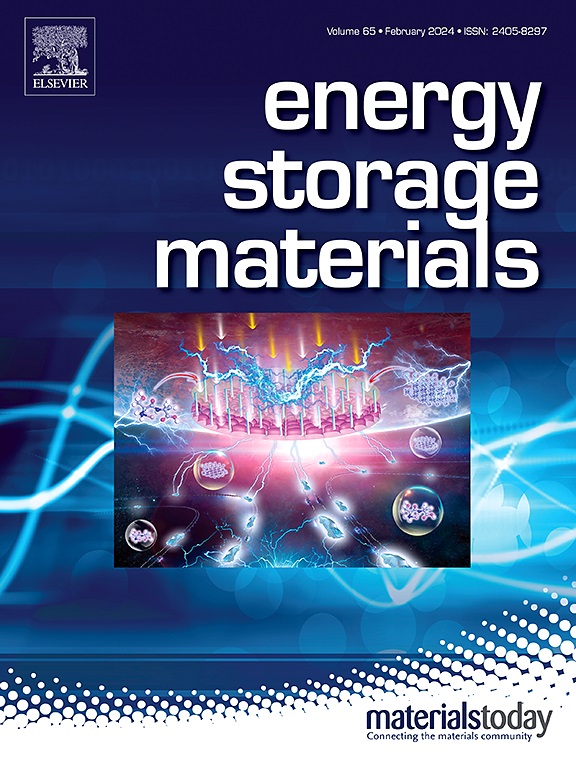原位聚合高弹性超薄层在固态锂金属电池中的动态界面调节
IF 20.2
1区 材料科学
Q1 CHEMISTRY, PHYSICAL
引用次数: 0
摘要
聚偏氟乙烯(PVDF)基固态电解质(sse)由于其相对较高的离子电导率和优异的柔韧性,在高能量密度固态锂金属电池(sslmb)中具有很大的前景。然而,它们的实际性能受到Li/PVDF界面不稳定性的阻碍,其中多孔PVDF导致离子沉积不均匀,残留的N,N-二甲基甲酰胺(DMF)溶剂引发与Li的严重副反应。在这里,我们证明了通过原位聚合含有热塑性聚氨酯(TPU)的1,3-二氧氧烷(P-DOL)引入高弹性层,有效地稳定和动态调节Li/PVDF界面。TPU的加入提高了固化层的弹性模量,使循环过程中Li/PVDF界面的局部应力重新分布和亲密界面接触的动态保留,从而促进了致密和平坦的Li沉积形态,延长了循环寿命。此外,中间层防止DMF残留物和锂阳极之间的副反应,保持电化学稳定的接触。因此,具有TPU/P-DOL夹层的Li|PVDF|LiNi0.8Co0.8Mn0.1O2电池在1℃下可在800次循环中提供136 mAh g−1的容量。我们的研究结果证明了一种可扩展的界面工程策略,解决了基于PVDF的ssi的关键瓶颈,并显着提高了sslmb的性能。本文章由计算机程序翻译,如有差异,请以英文原文为准。
Dynamic interface regulation in solid-state lithium-metal batteries by in situ polymerized highly elastic ultrathin layers
Poly(vinylidene fluoride) (PVDF)-based solid-stated electrolytes (SSEs) hold great promise for high-energy-density solid-state lithium metal batteries (SSLMBs) due to their relatively high ionic conductivity and excellent flexibility. However, their practical performance is hindered by instability at the Li/PVDF interface, where the porous PVDF induces uneven ion deposition and residual N,N-dimethylformamide (DMF) solvent triggers severe side reactions with Li. Here, we demonstrate that a highly elastic layer, introduced via in situ polymerization of 1,3-dioxolane (P-DOL) containing thermoplastic polyurethane (TPU), effectively stabilizes and dynamically regulates the Li/PVDF interface. The incorporation of TPU enhances the elastic modulus of the cured layer, enabling local stress redistribution and dynamic retention of intimate interfacial contact at the Li/PVDF interface during cycling, which in turn promotes dense and flat Li deposition morphology to prolong the cycle life. Moreover, the interlayer prevents side reactions between DMF residues and Li anode, preserving an electrochemically stable contact. Consequently, the Li|PVDF|LiNi0.8Co0.1Mn0.1O2 cell with TPU/P-DOL interlayer delivers a capacity of 136 mA h g−1 over 800 cycles at 1 C. Our findings demonstrate a scalable interfacial engineering strategy that addresses the key bottleneck of PVDF-based SSEs and significantly advances the performance of SSLMBs.
求助全文
通过发布文献求助,成功后即可免费获取论文全文。
去求助
来源期刊

Energy Storage Materials
Materials Science-General Materials Science
CiteScore
33.00
自引率
5.90%
发文量
652
审稿时长
27 days
期刊介绍:
Energy Storage Materials is a global interdisciplinary journal dedicated to sharing scientific and technological advancements in materials and devices for advanced energy storage and related energy conversion, such as in metal-O2 batteries. The journal features comprehensive research articles, including full papers and short communications, as well as authoritative feature articles and reviews by leading experts in the field.
Energy Storage Materials covers a wide range of topics, including the synthesis, fabrication, structure, properties, performance, and technological applications of energy storage materials. Additionally, the journal explores strategies, policies, and developments in the field of energy storage materials and devices for sustainable energy.
Published papers are selected based on their scientific and technological significance, their ability to provide valuable new knowledge, and their relevance to the international research community.
 求助内容:
求助内容: 应助结果提醒方式:
应助结果提醒方式:


